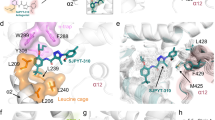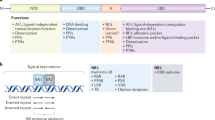Abstract
Targeted zinc-finger (ZF) DNA-binding domains in conjunction with nuclear receptor ligand-binding domains (LBDs) produce chemically inducible gene switches that have applications in gene therapy and proteomic and genomic research. The benzoate X receptor-β (BXRβ) LBD was used to construct homodimer and single-chain ZF transcription factors (ZFTFs). These ZFTFs specifically regulated the transcription of target genes in response to two ligands, ethyl-4-hydroxybenzoate and propyl-4-hydroxybenzoate, in a dose-dependent manner. The ZFTFs also regulated the expression of endogenous intercellular adhesion molecule-1 in response to either ligand. The advantage of BXRβ-based ZFTFs is that the ligands are inexpensive and easily synthetically modified, making the system a base for creation of orthogonal ligand–receptor pairs and expanding the gene-switch toolbox.
This is a preview of subscription content, access via your institution
Access options
Subscribe to this journal
Receive 12 print issues and online access
$259.00 per year
only $21.58 per issue
Buy this article
- Purchase on Springer Link
- Instant access to full article PDF
Prices may be subject to local taxes which are calculated during checkout




Similar content being viewed by others
References
Margolin JF, Friedman JR, Meyer WK, Vissing H, Thiesen HJ, Rauscher 3rd FJ . Kruppel-associated boxes are potent transcriptional repression domains. Proc Natl Acad Sci USA 1994; 91: 4509–4513.
Beerli RR, Barbas 3rd CF . Engineering polydactyl zinc-finger transcription factors. Nat Biotechnol 2002; 20: 135–141.
Jamieson AC, Miller JC, Pabo CO . Drug discovery with engineered zinc-finger proteins. Nat Rev Drug Discov 2003; 2: 361–368.
Beerli RR, Schopfer U, Dreier B, Barbas 3rd CF . Chemically regulated zinc finger transcription factors. J Biol Chem 2000; 275: 32617–32627.
Dent CL, Lau G, Drake EA, Yoon A, Case CC, Gregory PD . Regulation of endogenous gene expression using small molecule-controlled engineered zinc-finger protein transcription factors. Gene Therapy 2007; 14: 1362–1369.
Magnenat L, Schwimmer LJ, Barbas 3rd CF . Drug-inducible and simultaneous regulation of endogenous genes by single-chain nuclear receptor-based zinc-finger transcription factor gene switches. Gene Therapy 2008; 15: 1223–1232.
Desjarlais JR, Berg JM . Toward rules relating zinc finger protein sequences and DNA binding site preferences. Proc Natl Acad Sci USA 1992; 89: 7345–7349.
Beerli RR, Dreier B, Barbas 3rd CF . Positive and negative regulation of endogenous genes by designed transcription factors. Proc Natl Acad Sci USA 2000; 97: 1495–1500.
Beerli RR, Segal DJ, Dreier B, Barbas 3rd CF . Toward controlling gene expression at will: specific regulation of the erbB-2/HER-2 promoter by using polydactyl zinc finger proteins constructed from modular building blocks. Proc Natl Acad Sci USA 1998; 95: 14628–14633.
Segal DJ, Dreier B, Beerli RR, Barbas 3rd CF . Toward controlling gene expression at will: selection and design of zinc finger domains recognizing each of the 5′-GNN-3′ DNA target sequences. Proc Natl Acad Sci USA 1999; 96: 2758–2763.
Dreier B, Beerli RR, Segal DJ, Flippin JD, Barbas 3rd CF . Development of zinc finger domains for recognition of the 5′-ANN-3′ family of DNA sequences and their use in the construction of artificial transcription factors. J Biol Chem 2001; 276: 29466–29478.
Dreier B, Fuller RP, Segal DJ, Lund CV, Blancafort P, Huber A et al. Development of zinc finger domains for recognition of the 5′-CNN-3′ family DNA sequences and their use in the construction of artificial transcription factors. J Biol Chem 2005; 280: 35588–35597.
Dreier B, Segal DJ, Barbas 3rd CF . Insights into the molecular recognition of the 5′-GNN-3′ family of DNA sequences by zinc finger domains. J Mol Biol 2000; 303: 489–502.
Liu Q, Xia Z, Zhong X, Case CC . Validated zinc finger protein designs for all 16 GNN DNA triplet targets. J Biol Chem 2002; 277: 3850–3856.
Maeder ML, Thibodeau-Beganny S, Sander JD, Voytas DF, Joung JK . Oligomerized pool engineering (OPEN): an ‘open-source’ protocol for making customized zinc-finger arrays. Nat Protoc 2009; 4: 1471–1501.
Liu Q, Segal DJ, Ghiara JB, Barbas 3rd CF . Design of polydactyl zinc-finger proteins for unique addressing within complex genomes. Proc Natl Acad Sci USA 1997; 94: 5525–5530.
Nagy L, Schwabe JW . Mechanism of the nuclear receptor molecular switch. Trends Biochem Sci 2004; 29: 317–324.
Sonoda J, Pei L, Evans RM . Nuclear receptors: decoding metabolic disease. FEBS Lett 2008; 582: 2–9.
Nishikawa J, Saito K, Sasaki M, Tomigahara Y, Nishihara T . Molecular cloning and functional characterization of a novel nuclear receptor similar to an embryonic benzoate receptor BXR. Biochem Biophys Res Commun 2000; 277: 209–215.
Moore LB, Maglich JM, McKee DD, Wisely B, Willson TM, Kliewer SA et al. Pregnane X receptor (PXR), constitutive androstane receptor (CAR), and benzoate X receptor (BXR) define three pharmacologically distinct classes of nuclear receptors. Mol Endocrinol 2002; 16: 977–986.
Grun F, Venkatesan RN, Tabb MM, Zhou C, Cao J, Hemmati D et al. Benzoate X receptors alpha and beta are pharmacologically distinct and do not function as xenobiotic receptors. J Biol Chem 2002; 277: 43691–43697.
Soni MG, Carabin IG, Burdock GA . Safety assessment of esters of p-hydroxybenzoic acid (parabens). Food Chem Toxicol 2005; 43: 985–1015.
Kinzel O, Fattori D, Muraglia E, Gallinari P, Nardi MC, Paolini C et al. A structure-guided approach to an orthogonal estrogen-receptor-based gene switch activated by ligands suitable for in vivo studies. J Med Chem 2006; 49: 5404–5407.
Schwimmer LJ, Rohatgi P, Azizi B, Seley KL, Doyle DF . Creation and discovery of ligand-receptor pairs for transcriptional control with small molecules. Proc Natl Acad Sci USA 2004; 101: 14707–14712.
Wu H, Yang WP, Barbas 3rd CF . Building zinc fingers by selection: toward a therapeutic application. Proc Natl Acad Sci USA 1995; 92: 344–348.
Magnenat L, Blancafort P, Barbas 3rd CF . In vivo selection of combinatorial libraries and designed affinity maturation of polydactyl zinc finger transcription factors for ICAM-1 provides new insights into gene regulation. J Mol Biol 2004; 341: 635–649.
Jahnke A, Van de Stolpe A, Caldenhoven E, Johnson JP . Constitutive expression of human intercellular adhesion molecule-1 (ICAM-1) is regulated by differentially active enhancing and silencing elements. Eur J Biochem 1995; 228: 439–446.
McKenna NJ, Lanz RB, O'Malley BW . Nuclear receptor coregulators: cellular and molecular biology. Endocr Rev 1999; 20: 321–344.
Acknowledgements
This study was supported in part by the National Institute of Health Grant R01GM065059 (CFB). LJS was supported by The American Cancer Society Illinois Division—Linda M Campbell Postdoctoral Fellowship.
Author information
Authors and Affiliations
Corresponding author
Ethics declarations
Competing interests
The authors declare no conflict of interest.
Additional information
Supplementary Information accompanies the paper on Gene Therapy website
Supplementary information
Rights and permissions
About this article
Cite this article
Schwimmer, L., Gonzalez, B. & Barbas, C. Benzoate X receptor zinc-finger gene switches for drug-inducible regulation of transcription. Gene Ther 19, 458–462 (2012). https://doi.org/10.1038/gt.2011.112
Received:
Revised:
Accepted:
Published:
Issue Date:
DOI: https://doi.org/10.1038/gt.2011.112



